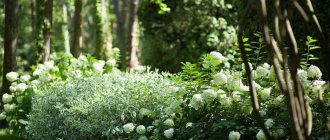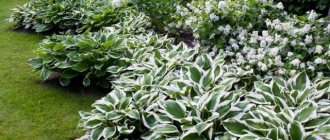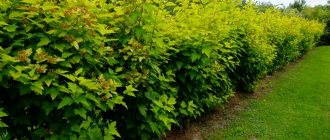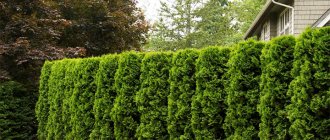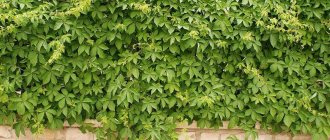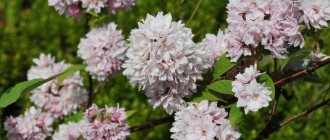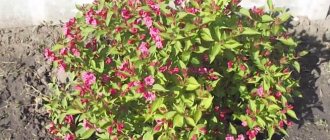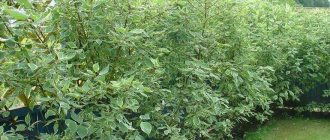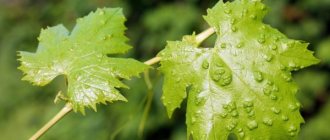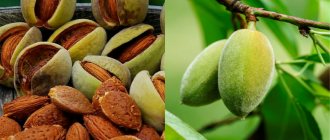Derain is a distant relative of the silky pigweed. As you can see in the photo of the tree, it has an attractive appearance and is quite easy to care for. Its homeland is China, and it can also grow in Korea, Japan and some parts of Russia. The plant's favorite habitat is marshy areas. White derain is the most common type.
Description
Derain varieties are small shrubs with slightly bare branches. The maximum height that the plant can reach is 3 m. The leaves are green, at the edges and turning darker towards the base.
The flowers have four petals gathered in a bunch. Variegated dogwood has fruits in the form of blue berries. The plant begins to bloom and bear fruit from the age of 3 years.
Derain has great endurance compared to other plants. It is not afraid of temperature changes, adapts to any season, and is not picky about the types of soil and fertilizers. Its unpretentiousness matches its attractive appearance.
White Derain varieties
A significant number of varieties have been bred through selective breeding and are used in horticulture. White dogwood, the most suitable varieties of which are in demand in our climate zone:
Derain White variety Aurea (Cornus alba 'Aurea')
A trouble-free shrub for a sunny area. Typically grown for its colorful stems, which add incredible color to the conservatory.
Cornus alba 'Aurea' is an easy to grow shrub. The flowers are cream-colored and the large leaves are golden in color. it requires moist, well-drained soil, but can also tolerate consistently wet areas. Height up to 3 m, width - 2.4 m.
White Siberian dogwood (Cornus alba Sibirica)
Decorative, spreading plant. The height reaches three meters. The bark of the branches is coral in color and takes on a fabulous appearance in the cold season.
Photo of Cornus alba Sibirica in the winter garden
The foliage is dark green in color and has an oblong, ovoid shape. In autumn, it changes color to burgundy and purple. The plant belongs to the long-flowered family. Shield-shaped inflorescences of snow-white flowers are a natural decoration of the bush. As the buds fade, fruits are formed, which when ripe have a bluish-gray color.
White dogwood Elegantissima (Cornus alba Elegantissima)
Quite a large shrub with widely spreading branches.
White dogwood Elengatissima (Cornus alba Elegantissima)
A characteristic feature of Elengatissima is its foliage, which is more than 8 cm long and has a wide white border along the edge of the rich green leaf. Flowering period is May-June.
White dogwood Sibirica variegata (Cornus alba Sibirica Variegata)
A variegated form of Derain Siberica with stunning foliage. A medium-sized deciduous shrub that produces a tuft of slender stems that turn bright red in winter. The leaves are originally variegated, dark green foliage has a cream edging. In autumn, before falling, the leaves turn crimson.
The stems of Cornus alba Sibirica color best in full sun, and the color is brightest on young stems, so the stems should be cut back to the ground regularly (half the stems each year). Small greenish-white flowers exude a delicate aroma. When ripe, the fruits take on a bluish color.
White dogwood Spaethii (Cornus alba Spaethii)
A spreading shrub, grows to a height of 2 m. The leaves are large, light green with a cream border. By autumn they change color to purple.
Photo of White Spethii Deren (Spaethii)
The red-brown bark of the bush is most decorative in winter, when it contrasts with the snow-white background of snow. Flowering period is May-July. The flowers are small and snow-white. Shpeta is unpretentious in care, shade-tolerant, frost-resistant, and easily tolerates drought.
How to plant a plant?
Planting derena does not have any special rituals or requirements. Thanks to its unpretentiousness, everything can be done quickly and easily. Planting must be done in the spring or during the fall of leaves. Many people prefer to plant turf in the fall, as the seedlings immediately begin to grow.
If you decide to replant in the spring, make sure that as much native soil as possible remains on the roots of the plants. This will ensure comfortable adaptation to the new place.
The composition of the soil does not matter; it can adapt to any composition. The only limitation is the acidity of the soil.
The plant can be transplanted no later than 4 years. The roots take root better and produce many more young shoots after pruning the tree.
Features of caring for derain shrubs
Almost all types and varieties of derain are undemanding to growth conditions:
- Dogwood is suitable for fertile, fairly moisture-rich loam with neutral acidity.
- Female dogwood grows well in fertile, moist soil. Does not like areas with stagnant water. The cuttings are all taking root.
- White dogwood grows on wet sandy loams, near reservoirs, in floodplains, and is not afraid of rising groundwater, for which it is valued by gardeners with similar characteristics of sites. It can grow not only in partial shade, but completely under trees, the roots do not spread out. Tolerates cold winters and recovers well after frost damage.
- Red dogwood grows well in calcareous areas, is not afraid of shade, and can be trimmed.
- Swedish dogwood is propagated by seeds stratified for 3-4 months or by dividing the bush in the spring. The plant is frost-resistant, prefers partial shade, although it develops in the shade and in the sun. Planted on loams, sandy loams, peat bogs with a slightly acidic reaction. Moist, drained areas, including swampy ones, are suitable for planting. In the middle zone, collectors grow Swedish derain together with heathers, since the crops are characterized by the same requirements for composition, lighting and soil structure. The plant is provided with partial shade, especially in the middle of the day, and moisture.
- Kousa derain develops well on light soils, slightly acidic or neutral. Propagated by stratified seeds, sown in spring, green cuttings or grafting. Tolerates frosts down to – 17-23 °C.
Plants are watered during drought, fed with nitrogen fertilizers in the spring, and maintained with compost or peat in the summer. Pruning is carried out in the spring. All species are less susceptible to diseases and pests if you adhere to agricultural practices. An infusion of soap, soda or mustard is used against aphids. Pesticides are used if necessary.
Care
The plant is not too demanding, but still requires some attention. Namely: regular watering, loosening the soil and removing weeds. The flower will like it if it is trimmed and treated against pests.
Young plants especially need constant watering 1-2 times a week. Newly transplanted plants should be watered at similar intervals. An adult is watered as it dries. During hot periods, no more than 3 waterings per month are needed. It is recommended to loosen the soil and pull out weeds after watering.
Feeding is not necessary, especially if the red turf grows in fertile soil. For prevention, you can fill it with a mineral solution.
An attractive appearance is maintained by pruning. To prevent the plant from looking too voluminous, it is necessary to trim every third branch. This way it will be compact and pleasing to the eye.
How does turf propagate?
The crop can be propagated in a garden plot in several ways: seeds, cuttings, layering, and dividing the bush.
Germination of seeds
Decorative onions - planting and care in open ground
Long before planting, the seeds are stratified: kept for 2-3 months in a cold place, for example, in a refrigerator. Then do the following:
- a mixture of sand and peat is poured into the box;
- plant seeds;
- cover the box with plastic wrap.
The container is placed in a room with a temperature of 18-20°C. When 3-4 leaves appear, the seedlings are transplanted into separate containers.
Important! Grown plants are planted on the site after 2 years.
Rooting cuttings
This is the most commonly used method of propagating turf. To do this, slightly lignified cuttings are cut and planted in containers or a greenhouse in June. They are grown for at least a year, then planted in open ground.
Rooting by cuttings is the most common method of propagating turf.
Replanting turf
Grown seedlings are transplanted to the site as follows:
- dig a hole 2 times larger than the earthen clod;
- pour in the nutrient mixture;
- a young plant is planted;
- lightly compact the root circle;
- water abundantly.
To preserve moisture, the ground around the bush can be mulched.
Note! If the root system has dried out during transportation, it should be placed in a container with water for several hours.
Possible problems in growing
The turf shrub, as it is sometimes mistakenly called, has good immunity, but if not properly cared for it can be affected by certain diseases. For example, dense planting increases the likelihood of powdery mildew. To prevent the appearance of fungal diseases, shrubs are sprayed with fungicides several times a season.
Against fungal diseases, turf is sprayed with fungicides
Curling and subsequent drying of the leaves can occur under stress caused by prolonged drought or excessive soil moisture. The same symptoms appear with excessive feeding. Having corrected the maintenance problems, the gardener will restore the decorative appearance of the shrubs.
Derain is one of the spectacular garden plants. It is beautiful, easy to care for, and retains its decorative appearance even in winter. If the shrub is properly cared for, it will serve as a decoration for the site for a long time.
Reproduction
Reproduction occurs by seed, cuttings and layering. Almost every seed sprouts. Derain is planted in the fall, but it can also be planted in the spring. They take a long time to sprout. You must be prepared for the fact that you will receive a formed variegated dogwood bush after at least 8 years.
There is a faster way to grow a derain bush - by cuttings. At the beginning of summer, it is worth cutting off a healthy shoot and planting it in the soil.
It is best to keep cuttings in a greenhouse; it is necessary to constantly moisten the plant, feed it and water it with mineral fertilizers in full so that the sprouts turn into a healthy, formed bush.
You can propagate turf using layering. This is the simplest method, which is performed in the spring. To do this, you need to bend the flexible branch towards the ground and bury it in the ground. Only the very top should remain sticking out.
In the summer, water the cuttings and do not let them dry out. In winter, it is recommended to cover young shoots with leaves or spruce branches.
Derain blood red
Somewhat less common in landscape design is blood-red turf (blood-red turf). Natural habitat is the European part of Russia, the Carpathians, Scandinavia, the Caucasus. Prefers forest edges, wet places near lakes and rivers. In such conditions, the shrub reaches 3-4 m, has flexible shoots of green color, but with age they acquire a reddish tint. It also has bright, green, egg-shaped leaves that are covered with hairs. At the end of the month of May, corymbose inflorescences bloom. Flowering occurs every year, starting at age seven, and lasts two weeks. Sometimes a second flowering occurs in August.
The fruits ripen in the fall, and the leaves actually take on a bloody red hue.
This shrub is also well adapted to urban conditions, winter-hardy, tolerates drought and shade well, but prefers moist sandy loam or fresh loose loam. Recovers very quickly after a haircut. Shrubs are also used for other purposes: baskets and hoops are woven from its shoots, and the wood is used to make carpentry. The oil present in the seeds is used for technical purposes. The shrub is a good soil fixer because it has many root suckers. Therefore, it is often planted in hedges and on slopes.
Use for decorative purposes
Plants are used as decoration in gardens, parks and home flower beds. Derain is an attractive bush that is planted both individually and in groups.
In summer, they delight the eye with their unusual leaves, and in winter with their bright colors peeking out from under the snow cap. In cloudy weather, such bushes will lift your spirits with their brightness and unusualness.
Application in medicine
All parts of the tree have medicinal properties. Tinctures and decoctions are made from berries, bark and young roots. They act as an antiviral, antipyretic, diuretic, and anti-inflammatory agent.
The fruits are very healthy; they tone and strengthen the body as a whole. Tincture from the roots helps against a large number of diseases.
Protection from pests and diseases
As is already known, derain is a universal plant that does not suffer from diseases and is extremely susceptible to pests. But this happens and you need to know how to deal with it.
To cure, the bushes should be treated with an insecticide. Spraying should be carried out in dry weather, otherwise the efforts will be in vain. Follow safety regulations and read the instructions carefully.
You can also use decoctions and tinctures of wild flowers. 1 kg of dandelions, yarrow, marigolds or celandine is poured with 5 liters of water, infused and filtered. After cooling it can be processed. Repeat several times every 5-7 days.
By following all the care rules, you will get beautiful shrubs that will delight you for many years.
